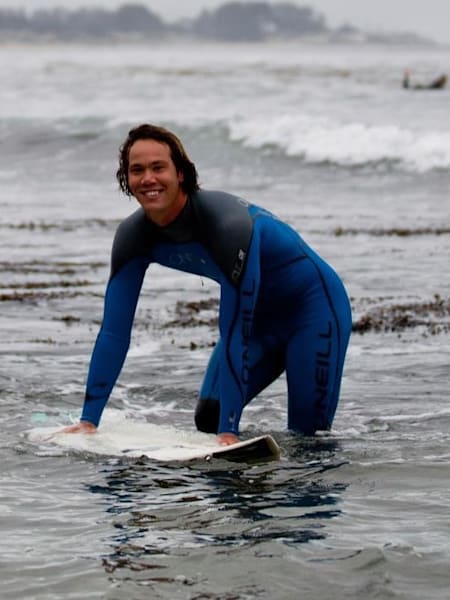Surfing
You’ve got your board sorted and you’re amped for a big day out on the waves. Someone told you about a sweet spot to check out, and the conditions look good: neat swell, not too raging, but totally worthy. Yet despite that glorious sun glazing over your skin and the sand under your feet, the first few moments in the whitewash bring a stunning revelation: the water is bloody freezing.
Whether on the shores of southern Australia, the tropics up north, or the mystical shores of some far-off equatorial break, few surfers ever plunge into the drink without that “other” crucial piece of gear: the humble, all-purpose wetsuit. Whether a steamer, shorty, or even a basic rash vest, having the right attire for the occasion is an essential ingredient to a smooth ride.
Today, we’re engaging again with our Surfing Sage, and a few other nuggets of wetsuit wisdom, to get the lowdown on how to choose the right board riding attire: what’s available, what you need to think about, where to get a good wetsuit, and how to get the most out of it.
The history of wetsuits
You don’t have to ask our Surfing Sage, lifelong rider, traveller and all-round surf head, Craig Regan, twice about whether wetsuits are an indispensible addition to the surfing kit.
“Wetties are cool; obviously if you’re in a warm climate, you probably don’t bother so much, but if you’re in a cold one, you definitely need one.”
Wetsuits became a thing in 1952, when a clever fella named Hugh Bradner, physicist at the University of California-Berkeley, created a prototype out of neoprene, the elasticky, lightweight synthetic rubber still widely used in wetsuits today.

1 min
ABC of Surfing: Zen Zip
Performance coach Andy Walshe explains what a zen zip is and what it's used for
As for the mechanics, the wetsuit’s multiple layers work to generate thermal insulation by fitting snugly around your body, then using the layer of water between your body and the suit to trap in heat. The important thing to remember here is that word snugly – a suit needs to fit, and if it’s too baggy or loose, the crucial layer of water won’t be trapped properly and you won’t feel anywhere near as toasty.
Yet as unique as Doc Bradner’s invention was back in the day, it’s taken the better part of 50 years for the prototype to really find its groove.
Wetties: Then and Now
“The thing with wetsuits,” says Regan, “ is that surfers have always hated them.”
The “soul riders” back in the day, as Regan points out, wanted to feel like they were naked when they were riding the waves. “That’s why boardshorts came out: because you could surf in them without undies and feel like you’re surfing with nothing on. In the ‘70s that was the thrill, because you started to feel so free and lose.”
Wetsuits, conversely, gave the opposite of that feeling.
“They were these thick things that used to constrict you – you’d paddle hard, but you couldn’t wind your shoulder over because you’ve got this rubber thing on you.”
Thankfully, enhanced technology has led to some rapid improvements in wetsuit functionality, with today’s offerings substantially more comfortable, and manoeuvrable, for all skill levels.
“I’ve got a super stretch wetsuit,” says Regan. “It feels light, but it’s got the warmth of a full suit; it’s a very stretchy material. They’ve made this material so elastic, and yet they’ve kept and even multiplied the warmth.”
The innovations have come thick and fast in recent years: like Rip Curl’s ‘Flex Energy’ system, which generates a heat particle in the suit to warm your body through friction – as you roll your shoulder over, it essentially functions like a turbine, generating warmth.
Other brands have been devising their own unique takes on traditional design, such as Xcel’s Thermo Dry Celliant (TDC), a lining that turns your body heat into infrared energy to keep you turbo toasty; O’Neill’s ‘Psycho Tech’ Air Firewall, which traps in heat more efficiently and makes for a awesomely lightweight and effortless paddle; and Patagonia’s world first sustainable natural rubber. (Check out Surfer Mag’s sweet in-depth run down on all the latest action).
On a more practical level, pretty much all the brands on the market have eliminated the need for zips and excess seams too, delivering a wetsuit experience worlds apart from the old restrictive models, and something far closer to the soul rider freedom of the ‘70s.
Types of Wetsuits
Getting on to styles, surfers tend to opt for around four or five different varieties, depending on the climate and conditions:
- The Full Suit
Fairly implicit in its name, the full suit is the whole deal: long in the arms and legs, and perfect for the chillier occasions out on the waves. Also known as the “steamer”, this one offers different thicknesses depending on how cold you’re keen to go (and for how long), anywhere from 2/3mm to as much as 6mm (and from 11 to below 7 degrees – for serious chill, make sure to get one with a hood).
- The Short Arm Steamer
Much the same as the full suit, but with shorter arms. Obviously this is a better choice for paddling flexibility, though having your arms exposed can be a heat risk if you find yourself in chillier waters. This is often a great choice for autumn in colder climates.
- The Spring Suit
Short arms, short legs: a ripe choice for spring, summer, and slightly warmer climates.
- The Long Jane / Long John
Akin to the garments of the same name, the legs go long here, while the arms stay short. Again, sweet for paddling, but with a decent warmth quotient.
(See also: The Short Jane / John; the Wetsuit Vest; and the Wetsuit Jacket).







